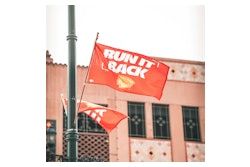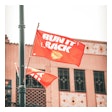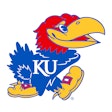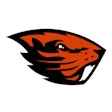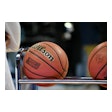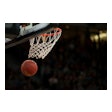On March 10, 2009, the Dallas Cowboys unveiled the first completed luxury suite at the team's $1.15 billion home field, which opened three months later. A sumptuous 700 square feet, the 18-seat suite utilized materials such as Brazilian granite, Canadian marble, leather-clad walls and walnut trim.
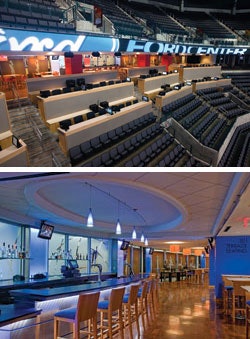 Oklahoma City Arena, previously known as the Ford Center, was transformed through the addition of
Oklahoma City Arena, previously known as the Ford Center, was transformed through the addition ofOn March 10, 2009, the Dallas Cowboys unveiled the first completed luxury suite at the team's $1.15 billion home field, which opened three months later. A sumptuous 700 square feet, the 18-seat suite utilized materials such as Brazilian granite, Canadian marble, leather-clad walls and walnut trim. A Dallas Morning News reporter took note of the crocodile leather wrapping the front of the bar, as well as the Woodford Reserve bourbon, Patrón Silver tequila and other bottles of premium liquor that stood behind it. All this could be yours (or, more typically, your company's) for $175,000 a year plus food and beverages fees.
Cowboys Stadium has gotten enthusiastic reviews both in the media and among the team's supporters, and its premium seating options (300 suites and 15,000 club seats), its 11,520-square-foot scoreboard and its restaurants, clubs and party decks have been in full view of hundreds of millions of curious people worldwide during the run-up to this month's Super Bowl XLV. But the stadium is something of a paradox. It's both the most technologically advanced venue in the United States and a throwback to what is beginning to feel like a bygone era - the gilded age before the American economy tanked.
The ongoing celebration of all that Texas-sized glitz masks a deepening problem for most operators of spectator facilities - how to manage and sell seat inventory in the teeth of a recession. Corporate purse strings everywhere have been cinched, and consumption is becoming less conspicuous - this following a period of construction and renovation that has saturated the country's 75 biggest markets with 30,000 suites and 800,000 club seats.
Bill Dorsey, executive director of the Association of Luxury Suite Directors, warned on cnbc.com last spring of "a tremendous paradigm shift" in the premium seating market. "The days of long-term 10-year 'Founders' leases and exclusively publicly financed venues appear to be over," he concluded, before hedging with, "at least for the next 18 to 24 months."
"I don't think this recession compares with 1930," he says now. "Premium seating is still a $10 billion marketplace. But occupancy rates have probably dropped 10 percent on average - the model is a bit broken and needs to be fixed. Fortunately, the teams are starting to figure it out. They're beginning to adjust and adapt."
Each market comes with its own set of challenges, but for years, premium seating in general seemed almost immune to market forces. Teams built it, and people came. But the truth is that a certain "arms race" mentality led a number of teams to construct premium seating options for which there was not an obvious market. With suites, for example, there may not have been the requisite number of corporations with the widely accepted threshold of $20 million in annual revenues. The same has been true of club seats, with many teams designating hundreds if not thousands of seats as "premium" in locations that aren't in particularly high demand. The oversupply has had a secondary effect, dampening the feeling of exclusivity that tends to make a premium seat an easier sell. And now, the pool of prospects has shrunk.
"I think everyone's concerned," says Don Dethlefs, CEO of Denver-based architects Sink Combs Dethlefs. "All the way down the line, whether it's people buying suites or club seats, companies buying sponsorships, people just showing up, there's an overall concern about people cutting back. And they are - they're asking, 'Where can we best spend our money?'"
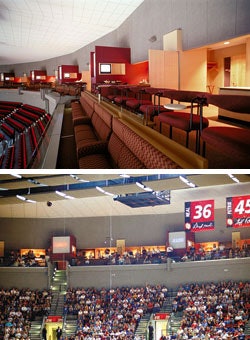 Blazer Boxes at Portland, Ore.'s Rose Garden transformed the least popular real estate at the corners of the upper bowl into a premium seating area featuring suites that are rented on a game-by-game basis. (Photo by Eckert + Eckert Photography, courtesy of Ellerbe Becket, an AECOM Company)
Blazer Boxes at Portland, Ore.'s Rose Garden transformed the least popular real estate at the corners of the upper bowl into a premium seating area featuring suites that are rented on a game-by-game basis. (Photo by Eckert + Eckert Photography, courtesy of Ellerbe Becket, an AECOM Company)Facility operators are asking the same question. Start with older-style luxury suites (16 seats fronting a living room and private restroom), which are a stadium or arena's least flexible premium seating space. An entire length of unsold suites could conceivably be gutted and reconfigured as one larger, albeit narrow private club space, but at a significant up-front cost. While many facilities go this route, an even greater number choose to repackage unsold seating inventory. If the number of corporate clients for one-year (or multiyear) suite leases is limited, simply selling suites on a shared, split or per-event basis can make them affordable to a much larger swath of the local business community.
There is, of course, nothing simple about this. Eighty suites with long-term leases meant 80 sales, as opposed to, say, more than 300 for a 40-game home basketball schedule. In addition, each sale was within a closed community of corporate clients; the availability of suites for bachelor parties, weddings and other personal events means a change in the way suites are marketed and in the type of customer service required. These hassles have led a number of teams to contract with third parties (such as SuiteAgent.com) to handle the buying and selling of suites.
"The per-event marketplace will only grow," Dorsey predicts. "In the lease business, you have 30,000 suites and only a couple hundred companies in the country that can really afford them. It could take 20 years, but the long-term solution is getting facility operators out of the lease business and into the per-event business."
Bill Crockett, principal and national director of sports for architects AECOM Ellerbe Becket, says it's clear even to the most hesitant of facility operators that suites will require daily handling from here on out, if only because the recession has managed to send everyone, high rollers included, in search of value.
"Any facility is always competing with an ever-changing and seemingly escalating set of expectations," Crockett says. "Customers now expect to be able to tweet and use their iPad, and there's almost an instant expectation that you'll be current with technology. Suites have always been about offering a less-crowded, business atmosphere, but they're also rooted in an owner being able to deliver a better fan experience with better amenities. I think the fundamental proposition for the operator is still that premium areas reward their best customers with something of real value, whatever that value is."
Recent design of premium seating areas reflects the wider array of potential, shorter-term buyers. Gone is the ring of traditional, one-size-fits-all suites; in their place are different premium seating options, now typically offered in combination:
The club seat. A prime location in the seating bowl, with access to a "party room" behind.
The loge suite. Four to six comfortable, movable swivel chairs sit at a counter facing the game action, and a back counter holds that night's spread of food and drinks - but there's no living room to speak of for socializing. Guests wanting a larger communal experience walk back to a club that services all of the private suites on that level (loge suites aren't strictly for loges).
The party deck. Neither upscale nor downscale (and likened by the Dallas Cowboys, who built one, to the Churchill Downs infield), it's still a "special" configuration of seating that sometimes doesn't even have seats. The standing-room-only deck in the Cowboys Stadium end zone - a component of many modern ballparks - reportedly has some arena owners considering replicating it.
The courtside bunker. It's a room with no view - a large private suite underneath the stands in the lower bowl with access to courtside seats for basketball. (The presence of dashers makes it more difficult, but still possible, to configure this for hockey, and anyway, as Dorsey notes, the courtside seat is a status symbol unique to basketball: "There was one week, if you wanted to watch the Knicks and sit next to Spike Lee, that seat was going for $52,000 on StubHub, the highest I'd ever seen. I don't get it, and I've been in the business 21 years.")
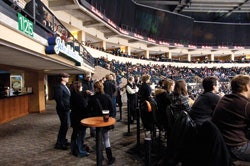 A lounge open to the seating bowl at the MTS Centre in Winnipeg, Man., is a special location that lacks the glitz associated with high-end luxury suites. (Photo by Mike Harvey, courtesy of Sink Combs Dethlefs)
A lounge open to the seating bowl at the MTS Centre in Winnipeg, Man., is a special location that lacks the glitz associated with high-end luxury suites. (Photo by Mike Harvey, courtesy of Sink Combs Dethlefs)Other recent upgrades are more superficial, though no less significant. For example, Ellerbe Becket, which designed "Blazer Boxes" into its recent renovations of the Portland Trail Blazers' Rose Garden - the upper-deck seats are essentially an updating of the opera box - is now pushing what it calls the "loft suite." Crockett explains, "It has a different level of finish, kind of an open, industrial feel like a Soho loft. It's not a reduction in the level of finish, but carries a look that the intended patrons can identify with."
Such alterations, even relatively minor ones, are necessary to combat what Dorsey calls a "been there, done that" attitude among ticket buyers that spells trouble for the luxury-suite industry. Whereas club seats' biggest selling point is typically the view - they are, in fact, the premium market's biggest producer of revenue, at 60 percent of the total take, because of their location in the front row or rows of each level - luxury suites are often located farther from the action, offering exclusivity and Patrón Silver in place of Spike Lee's aura. Dorsey has witnessed the latest suite transformations and likes what he's seeing. "There's a new generation of suites coming out that are very high-tech," he says, "and they're starting to look special again to me."
But low-tech - read "value" - is increasingly important, too, and Dethlefs was aware of this downward pressure in the market even before the bottom dropped out of the economy. "We've kind of downscaled some suites in our mid-size markets because people couldn't afford them," he says. "We'd already seen the trend coming, at least on the smaller buildings. Those suites are not as grand, obviously. The smaller size - two-thirds the size of suites 10 years ago - makes them more affordable, and people want that. Otherwise, they have to find other companies to go in with to buy one."
Clearly, satisfying the rarefied tastes of the wealthiest fans while responding to the cost concerns of the merely well-heeled requires a venue with a variety of premium seating options. Increasingly, spectator venues are designed with an eye toward accommodating different sizes of premium suites, as well as an understanding of how these areas fit in with surrounding concourses and clubs (such adjacencies must be considered in anticipation of suites being made larger or smaller, or being removed altogether, in the years ahead). From a design standpoint, loge suites are a better fit for most venues than full-fledged suites, and are thus proliferating - their lack of a living room takes away the need for grand fixtures (flat-screen TVs aside), so they are both less upscale and "inherently flexible," as Crockett says. "They're a cut above the general seating area, but not necessarily given a high level of finish," he says. "And if they're planned right, they can be adapted from year to year, to keep things fresh."
Oklahoma City Arena, which opened without a major-league tenant in 2002, has adapted significantly since the city acquired the NBA's Seattle Supersonics in late 2006 (the Oklahoma City Thunder began play in 2008). Built without luxury amenities because of citizens' concerns about expenditures until a major-league tenant could be found, the arena has since been transformed with the addition of private suites, party suites, bunker suites and, especially, "boatloads of loge suites," as Dethlefs says, in various places around the arena. "The idea was to mix a high-end product, a mid-priced product and a lower-end product, all in the high-end premium market," he says. "You have to create that kind of flexibility. Long term, you don't know where the market is going, and you don't want your building to be obsolete."
Dorsey doesn't see luxury suites going away - there will always be ultra-wealthy people who enjoy the prestige of a private public experience, and the type of corporate relationship marketing that suites foster "has worked forever," he says. However, the shift toward different luxury price points has him hopeful that facility owners are making the changes that are necessary to roll with the economic times. "Professional sports teams are a little behind the curve," Dorsey says. "But in the long run, this new reality for the premium markets might actually be better for the sports business marketplace, because it relies on developing a larger customer base."














